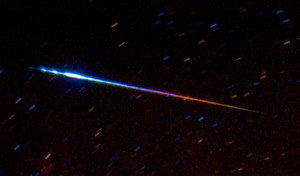Once a year the nighttime sky is lit up with fragments of Comet Swift-Tuttle. The Perseid meteor shower peaked last week and while a bright full moon limited viewing on Earth, astronauts on the International Space Station captured stunning imagery of the event.
Every 133 years Comet Swift-Tuttle makes a pass through the inner solar system spewing dust and gravel behind it. According to NASA, the debris zone is so wide that the Earth spends weeks inside of it.
The fragments from the comet slam into our atmosphere at an astounding 144,000 miles per hour and light up the night sky as they burn up. Most of these meteoroids are the size of grains of sand but some can be as large as marbles.
Called Perseids because they seem to fly out of the constellation Perseus in the northeast August sky, the end result is a bevy of shooting stars across the night sky. This past Saturday, the ISS crew was able to grab an image of a meteoroid shooting into the atmosphere as the station passed over China.

From NASA:
Many people have spent time outdoors under a dark sky, watching for “shooting stars” to streak across the firmament. In some cultures, this event is an occasion to make a wish; in others it is viewed as a herald of important events, such as the birth of a future ruler. While not actual stars, “shooting stars” do come from outer space, in the form of meteoroids entering the Earth’s atmosphere.
Meteoroids are small objects moving through the solar system that are attracted to the Earth by its gravitational pull. These small objects—typically fragments of asteroids or comets, though they can also originate from the Moon or Mars—begin to heat and burn up as they collide with air molecules in Earth’s atmosphere, creating a bright vapor trail or streak. At this point, the object is known as a meteor. If any remnant of the object survives to impact the Earth’s surface, it becomes known as a meteorite. While most meteorites are natural in origin, on occasion manmade space debris can reenter the atmosphere and also become a meteor or even a meteorite!
This astronaut photograph, taken from the International Space Station while over China (approximately 400 kilometers to the northwest of Beijing), provides the unusual perspective of looking down on a meteor as it passes through the atmosphere. The image was taken on August 13, 2011, during the Perseid Meteor Shower that occurs every August. The Perseid meteors are particles that originate from Comet Swift-Tuttle; the comet’s orbit is close enough for these particles to be swept up by the Earth’s gravitational field every year—leading to one of the most dependable meteor shower displays.
Green and yellow airglow appears in thin layers above the limb of the Earth, extending from image left to the upper right. Atoms and molecules above 50 kilometers in the atmosphere are excited by sunlight during the day, and then release this energy at night, producing primarily green light that is observable from orbit. Part of a space station solar panel is visible at image upper right; behind the panel, a bright region indicates the Sun low on the horizon.
Astronaut photograph ISS028-E-24847 was acquired on August 13, 2011, with a Nikon D3S digital camera using a 22 mm lens, and is provided by the ISS Crew Earth Observations experiment and Image Science & Analysis Laboratory, Johnson Space Center. The image was taken by the Expedition 28 crew. The image has been cropped and enhanced to improve contrast. Lens artifacts have been removed. The International Space Station Program supports the laboratory as part of the ISS National Lab to help astronauts take pictures of Earth that will be of the greatest value to scientists and the public, and to make those images freely available on the Internet. Additional images taken by astronauts and cosmonauts can be viewed at the NASA/JSC Gateway to Astronaut Photography of Earth. Caption by William L. Stefanov, Jacobs/ESCG at NASA-JSC.

